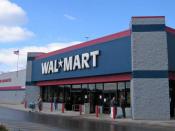Final PaperStakeholders "rely on the company's periodic financial statements to provide basic information on the profitability of the firm" (Brealey et al, 2003, pg. 449). The information included in this paper will illustrate Wal-Mart and Target's history, products and services, and annual reports. These reports are intended to provide investors, creditors, and shareholders a glimpse into the financial successes and challenges a company goes through in a given year. Team A will use financial ratios to compare and analyze data from Wal-Mart and Target's balance sheet, income statement, and statement of cash flow. The paper will also highlight internal events that affect the company's cash position including cash generated by operating, financing, and investing activities. The impact of variable expenses will be discussed and five operating expenses will be given for three fiscal years along with an evaluation of operating leverage. Finally, Team A will compare areas of cash flow, operating, risk management, and profitability analysis for Target and Wal-Mart.
History of Wal-MartOn July 2, 1962, Walton opened the first Wal-Mart store, Wal-Mart Discount City. Within five years the company expanded to 24 stores across the state of Arkansas and reached $12.6 million in sales. The company was incorporated as Wal-Mart Stores, Inc. on October 31, 1969, and in 1970 opened its home office in Bentonville, Arkansas, and its first distribution center (Wal-Mart, 2007). The company began trading stock at this time as a publicly held company on October 1, 1972, and was listed on the Ney York Stock Exchange shortly thereafter (Wikipedia, 2007). Wal-Mart continued to grow rapidly during the 1980s and by its 25th anniversary in 1987; there were 1,198 stores with sales of $15.9 billion and 200,000 associates (Wal-Mart, 2007).
History of TargetIn 1962, the Dayton Company, using a concept developed by John F. Geisse, entered discount...


